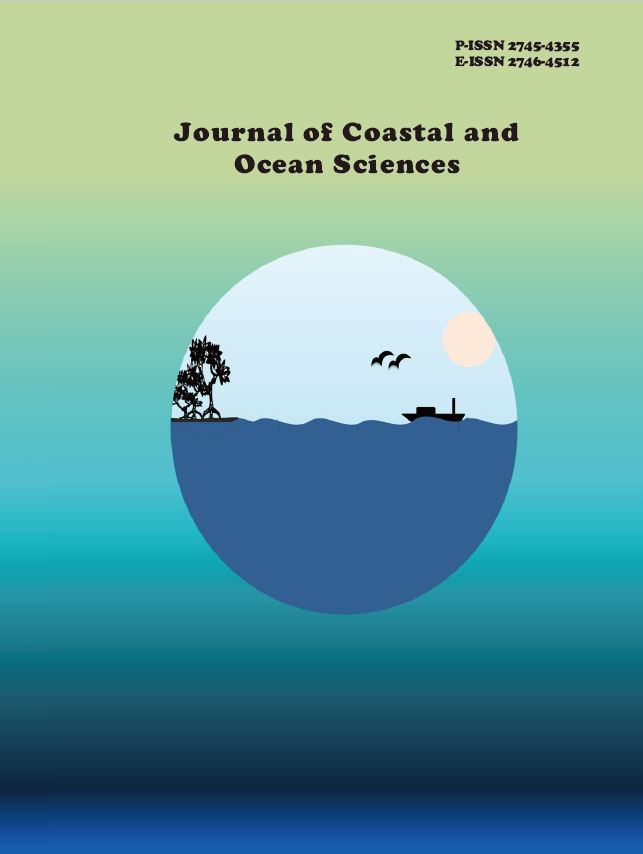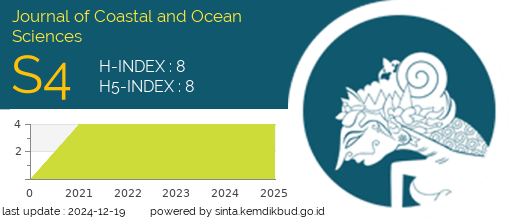Analysis of Microplastic Containment in Coral Grouper (Cephalopholis miniata) and Brown-Marbled Grouper (Epinephelus fuscogattatus) Grown on the Station of Baguk Island, Singkil Aceh
DOI:
https://doi.org/10.31258/jocos.5.2.131-134Keywords:
Tangkahan, Microplastics, Coral Grouper, Brown-marbled grouper, Baguk IslandAbstract
Baguk Island is one of several islands in the Aceh Singkil Regency. This water area is included in a coastal ecosystem widely used for various human activities, such as sea transportation routes; these activities can increase domestic and anthropogenic waste, including microplastics. The study aimed to determine the type and amount of microplastic content in coral groupers (Cephalopholis miniata) and Brown-marbled grouper (Epinephelus fuscogattatus), fish often consumed by the community. This research was conducted in August-November 2023 in the tangkahan of Baguk Island village using quantitative methods where data collection was carried out through field surveys and laboratory experiments based on the NOAA (National Oceanic and Atmospheric Administration) method but with several differences, namely the number of samples and the addition of hydrogen peroxide (H2O2) solution. The results of the identification of this study found as many as three types of microplastics in coral grouper fish, namely fragment, film and fiber types and four types of microplastics in Brown-marbled grouper fish with fragment, film, fiber and granule types
Downloads
References
Caruso, G. (2015). Plastic Degrading Microorganism as a Tool for Bioremediation of Plastic Contamination in Aquatic Environments. J. Pollut Eff Control 3(3).
Crawford, B.C., & Quinn, B. (2017). Microplastic Pollutants. United Kingdom: Elsevier Inc.
Gunawan, G., Effendi, H., & Warsiki, E. (2021). Microplastic Contamination of Pindang Fish and its Potential Hazard to Human Health, Case Study in Bogor. JPB Marine and Fisheries. 16(2): 105-119.
Jenna, R.J., Roland, G., Chris, W., Theodore, R., Siegler, S., Miriam, P., Andrady, A., Narayan, R., Law, K.L. (2015). Plastic Waste Inputs from Land into the Ocean. Science, 347 (6223).
Karbalaei, S., Golieskardi, A., Hamzah, H. B., Abdulwahid, S., Hanachi, P., Walker, T. R., & Karami, A. (2019). Abundance and Characteristics of Microplastics in Commercial Marine Fish from Malaysia. Marine Pollution Bulletin, 148: 5–15.
Pizzurro, F., Recchi, S., Nerone, E., Salini, R., & Barile, N B. (2022). Accumulation Evaluation of Potential Microplastic Particles in Mytilus galloprovincialis from the Goro Sacca (Adriatic Sea, Italy). Microplastics. 1(2): 303–318.
Putri, S.E. (2021). Identifikasi Kelimpahan Mikroplastik Pada Biota (Ikan) Di Perairan Pantai Sendangbiru Malang. UIN Malang.
Sudirman, R.I. & Aidah A. H. (2015). Perikanan Kerapu dan Kakap. WWF Indonesia.
Sulastri, E.H., Suryono, T., & Sudarso Y. (2008). Relationship of Land Use, Water Quality and Phytoplankton Community of Some Small Lake in West Java. Oseanologi dan Limnologi di Indonesia. 34(2): 307 – 332






